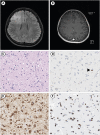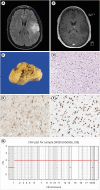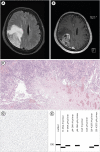Classification and Diagnosis of Adult Glioma: A Scoping Review
- PMID: 36742083
- PMCID: PMC9833487
- DOI: 10.12786/bn.2022.15.e23
Classification and Diagnosis of Adult Glioma: A Scoping Review
Abstract
Gliomas are primary central nervous system tumors that arise from glial progenitor cells. Gliomas have been classically classified morphologically based on their histopathological characteristics. However, with recent advances in cancer genomics, molecular profiles have now been integrated into the classification and diagnosis of gliomas. In this review article, we discuss the clinical features, imaging findings, and molecular profiles of adult-type diffuse gliomas based on the new 2021 World Health Organization Classifications of Tumors of the central nervous system.
Keywords: Brain Neoplasms; Classification; Diagnosis; Glioma.
Copyright © 2022. Korean Society for Neurorehabilitation.
Conflict of interest statement
Conflict of Interest: The authors have no potential conflicts of interest to disclose.
Figures




References
-
- Sanai N, Alvarez-Buylla A, Berger MS. Neural stem cells and the origin of gliomas. N Engl J Med. 2005;353:811–822. - PubMed
-
- Weller M, van den Bent M, Preusser M, Le Rhun E, Tonn JC, Minniti G, Bendszus M, Balana C, Chinot O, Dirven L, French P, Hegi ME, Jakola AS, Platten M, Roth P, Rudà R, Short S, Smits M, Taphoorn MJ, von Deimling A, Westphal M, Soffietti R, Reifenberger G, Wick W. EANO guidelines on the diagnosis and treatment of diffuse gliomas of adulthood. Nat Rev Clin Oncol. 2021;18:170–186. - PMC - PubMed
Publication types
LinkOut - more resources
Full Text Sources

